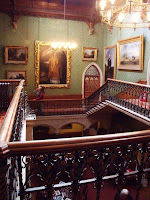Tyntesfield is a recent acquisition by the National Trust. In 2002 a very rare opportunity presented itself to the Trust, when Wraxall Estate came on the market, following the death of Lord Wraxall. However, the Trust could not do it alone and had to appeal to the public. In just 100 days the public collected £8.2 million. Together with a single largest grant by the National Heritage Memorial Fund, and a grant from the National Lottery for the restoration work, Tyntesfield was saved for the nation and can now be enjoyed by all.
Tyntesfield was a home to 4 generations of Gibbs family, who made their money in fertiliser, which came from South American guano. This made William Gibbs one the richest man in England. He bought the original Regency house in 1843 and in 1863 started a rebuilding work which resulted in Victorian Gothic Revival house we see today. There was no expense spared. The house was the first one in the area to have electricity, from their own generator and central heating, powered by steam.
Very little of the original house can be seen now, only some simple straight lines give us a clue where the original Regency part of the house is.
Tyntesfield is also unique, because it was lived in until 2001 and it was sold including all the furniture and fittings, be it in a neglected state. 50,000 items have been listed to date, many of them still in storage. The priority, following the purchase of the house, was to make it secure against elements, so until early this year it was hidden behind a scaffolding. You can watch the unveiling here.
We have been planning to visit for some time. This weekend was our last chance this year, as the house is now being "put to bed" for the winter, as the Trust calls it.
To protect the interior, the daylight is kept to the minimum and camera flash not allowed, but I took as many pictures as I could to show your this beautiful house.
These are animal bones, which were found below the bathroom floor, in 6" deep layer.
They were there to absorb moisture. The original dehumidifier?
The Gibbs family chapel.


























